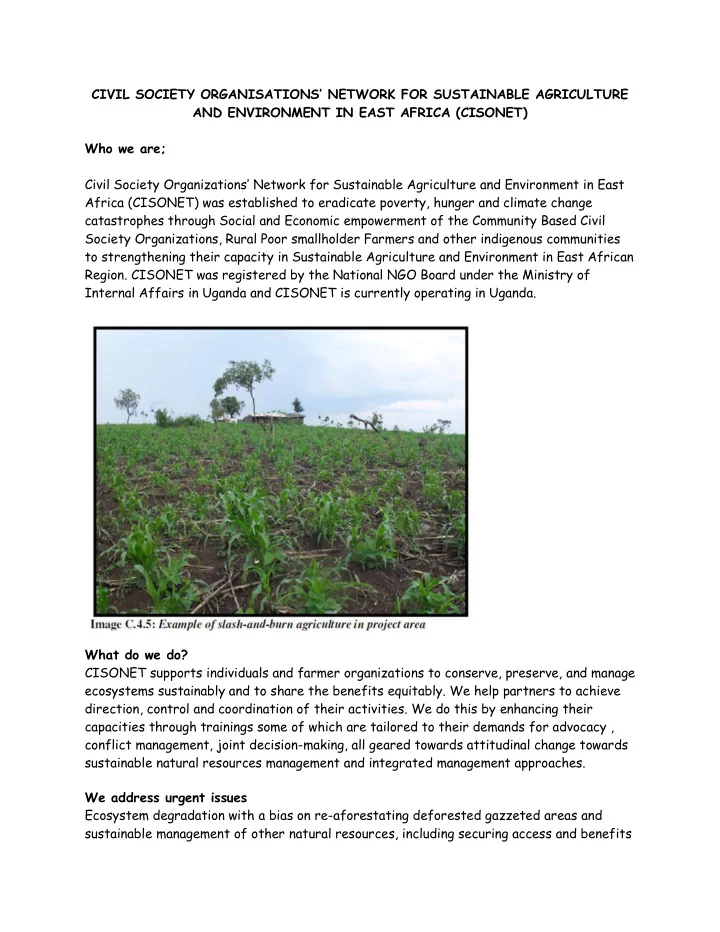

CIVIL SOCIETY ORGANISATIONS’ NETWORK FOR SUSTAINABLE AGRICULTURE AND ENVIRONMENT IN EAST AFRICA (CISONET) Who we are; Civil Society Organizations’ Network for Sustainable Agriculture and Environment in East Africa (CISONET) was established to eradicate poverty, hunger and climate change catastrophes through Social and Economic empowerment of the Community Based Civil Society Organizations, Rural Poor smallholder Farmers and other indigenous communities to strengthening their capacity in Sustainable Agriculture and Environment in East African Region. CISONET was registered by the National NGO Board under the Ministry of Internal Affairs in Uganda and CISONET is currently operating in Uganda. What do we do? CISONET supports individuals and farmer organizations to conserve, preserve, and manage ecosystems sustainably and to share the benefits equitably. We help partners to achieve direction, control and coordination of their activities. We do this by enhancing their capacities through trainings some of which are tailored to their demands for advocacy , conflict management, joint decision-making, all geared towards attitudinal change towards sustainable natural resources management and integrated management approaches. We address urgent issues Ecosystem degradation with a bias on re-aforestating deforested gazzeted areas and sustainable management of other natural resources, including securing access and benefits
for the poor, are key items on our agenda. The uncertainties and impacts of climate change render these issues all the more important. Efforts to halt the loss of biodiversity have proven inadequate. We believe that effective ecosystem management is as much a problem of ‘governance’ as it is a question of science and designing effective policies. We have an integrated perspective The Ecosystem Governance programme brings an integrated perspective to improving governance systems and policy implementation. We do this by: Applying an ecosystems approach to natural resource management Promoting transparent and democratic decision making Promoting the principle of surrounding community ownership and management of forest resources. Demonstrating how biodiversity conservation and poverty reduction can be combined CISONET strives to maintain the highest level of conservation and environmental protection of the eco-system, safeguarding and enriching areas of natural and indigenous forest to protect unique flora and fauna and promote bio-diversity. This concept of community sustainable forest management will ensure tangible contribution to the country, its people and our future and help combat global warming. CISONET EXTENSION STAFF VISITS A FARMERS’ TREE NURSERY FOR TECHNICAL SUPPORT
Our environmental management objectives are to: Promote the re-colonization of natural vegetation and biodiversity through enrichment planting regimes in the remaining natural and riparian forests with indigenous species that are or were found in the local environment; Enhance good and proper planting of seedlings, water quality and quantity by limiting erosion and the subsequent siltation of wetland area and the streams. To achieve this, CISONET is: Buying tree seeds and giving them to communities to establish community nurseries Give Agroforestry extension services to farmers (Boundary planting, Wood lots and crops integrated planting.) Lead and influence dialogues and partnerships with National Forest Authority on re-afforetating deforested reserves, this being done by the reserves surrounding communities. Lobby the local administrative council as we push for by-laws and audinancies on Agroforestry practices at household level. Creating buffer zones between planted areas and the stream that passes along Katabalalu forest reserve of at least 50m; Perform enrichment planting regimes with indigenous species like Khaya, Musisi (Maesopsis), Ficus and Albizia in the protected areas which will stabilize the soil; Plan and designate a network of natural areas, thus ensuring that natural corridors exist for the movement of indigenous fauna and flora. Ensure that the aesthetic appeal of the area is maintained by identifying, conserving and enhancing unique features of the landscape, using natural features such as watercourses to define compartment boundaries and, where practical, following the natural pattern of the land. Ensure that not less than fruit trees of different species are planted an boundaries, interplanted or as ornamentals in every home with ownership over their land
One of such community managed tree Nursery is given to every ten households. THANK YOU.
Recommend
More recommend